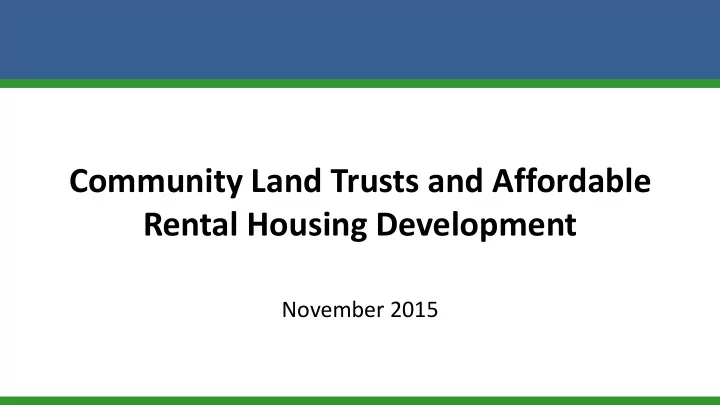

Community Land Trusts and Affordable Rental Housing Development November 2015
Outline 1. Introduction 2. Community Land Trust Model 3. Review of Land Trust Developments: Project Examples 3. Lessons and Conclusions 4. Questions and Discussion
Existing Co-ops in BC Existing Co-ops in BC • 260 260 • Approx. 15,000 Homes Approx. 15,000 Homes
Co-op Sector Challenges • • Reduced (or non- • An aging population Aging and often inefficient existent) government with changing infrastructure. support. accessibility needs. • • Limited financial • Sub-optimal unit mix. Deferred maintenance. means (and small scale operations).
Our Priorities Priorities 1. Keep the co-op housing we have. 2. Build more.
Priority #1 Keep What We Already Have • Replacement subsidies for low-income residents as federal agreements expire • Massive capital re-investment • More effective asset management strategies
Priority #2 Build More Co-op Housing • Wait for government to: build more co-op housing directly. incent the market to do it. OR • Mobilize community assets and partnerships (i.e. the Land Trust Model).
Community Land Trust Model What is a Community Land Trust? • A Community Land Trust is a non-profit or charitable organization that acquires and holds land for the benefit of a community. • Land is available in perpetuity for affordable housing. Housing typically targets low- and moderate-income residents in both rental and ownership models.
CHLTF VCLTF CLTF-BC Society (incorporated 1993) Society (incorporated 2014) Society (incorporated 2015) and Registered Charity Has 99-year leases on City of Key to new developments, Owns six properties leased by Vancouver properties on acquisitions, and major five co-ops and one society. Kingsway and in SE redevelopments of existing Vancouver (Kent & Marine co-ops. Responsible for the Drive). (a) Disability Trust and Provides and preserves (b) the Domestic Violence Partners with two non-profit housing opportunities for low Relief Fund. housing societies and and moderate income Fraserview Co-op. households.
Community Land Trust Model The Approach • Sector-led development. • Portfolio approach (development, operating). • Community partnerships. • Private equity. • Leveraging of City assets. • Platform for future opportunities. • Capacity building and surplus sharing.
Land Trust Developments Project Range • New co-op housing opportunities. • Redevelopment of existing co-ops (i.e. under utilized density). • Relocation of existing co-ops. Typically for a higher density to achieve a net gain of homes. • Renewal of existing co-ops (i.e. comprehensive renovations).
Land Trust Developments: Vancouver City of Vancouver • Request for Expressions of Interest by the City (August 2012) to "build and operate affordable (below market) rental housing on six sites.” • Objectives: Affordability Expedited delivery Innovative mix of tenure Livability
Location of Kingsway Development Location of Co-op Development
Land Trust Developments: Vancouver • Fraserview Housing Co-op • CHF BC • Tikva Housing Society • City of Vancouver • Sanford Housing Society • Vancity • BC Housing
358 Homes City of Vancouver Head lease Housing agreements (99 years) (Affordability obligations) Project consultants Vancity Architects Vancouver Community Land Trust Foundation Contractors BC Housing Legal advisors Operator Agreements Sanford Fraserview Fraserview Housing Housing Co-op Housing Society (80+108 = 188 units) Co-op (48 units) (90 units) Total of 278 units Tikva Housing Society over two sites. CRU (32 units) Kingsway Site East Marine Drive Site Kent St. Site A Community Land Trust Development Model
Site 3: 1700 Kingsway Mixed use: commercial/residential
Sites 4/5: Fraserview (towers), Tikva (townhomes)
Sites 4/5: Tikva Townhomes (View from East Kent Ave.) Family-centred housing
Land Trust Developments: Vancouver • City of Vancouver (land contribution) $24.7 million • Land Trust Partner equity 3.8 Proceeds from CRU sale 4.8 Fund equity 11.0 BC Housing equity 4.0 Lease-up income 2.0 Debt financing 69.3 • Total Project Capital $119.6 million
Land Trust Developments: Vancouver Significant Features • 7.7% return on investment measured in affordability in first year of operation. • Deep and continuing affordability (76% of market in year one and getting better over time). • Cross-site subsidies (capital and operating). • No operating subsidy from any level of government. • Future surplus shared by Land Trust and City. • Best practices in procurement and long-term asset management.
Land Trust Developments Additional Active Files • Metro Vancouver, the Fraser Valley and Vancouver Island. 3 - new development opportunities. 5 - redevelopment opportunities of existing sites 1 - relocation of an existing co-op 1 – renewal of an existing co-op 10 – Provincial Rental Housing Corporation transfer opportunity • Project costs range from $5m to $60m with each project having it’s own unique requirements for funds and financing.
Land Trust Developments Innovations and Advantages • A common table for community partners. • A single point of contact for our partners. • Portfolio-based leverage (capacity and scale). • Diversity of tenure and target populations. • Long-term stewardship and asset management. • Deep initial and ongoing affordability. • Platform for future opportunities.
Lessons and Conclusions Lessons (so far…..) • Everything will take longer and cost more. • Value stubbornness and resilience. • Choose the right partners. • Build internal capacity.
Lessons and Conclusions Looking Ahead • Don’t look back. • Start pooling our assets for mutual benefit. • Create economies of scale and net income. • Find the right balance between: short-term affordability and long-term sustainability neighbourhood autonomy and portfolio synergy • Generate capacity and energy for growth from within.
Lessons and Conclusions Critical Factors • Capital • Capacity • Partnerships • Scale
Thank You for Attending • Questions • Discussion
Recommend
More recommend